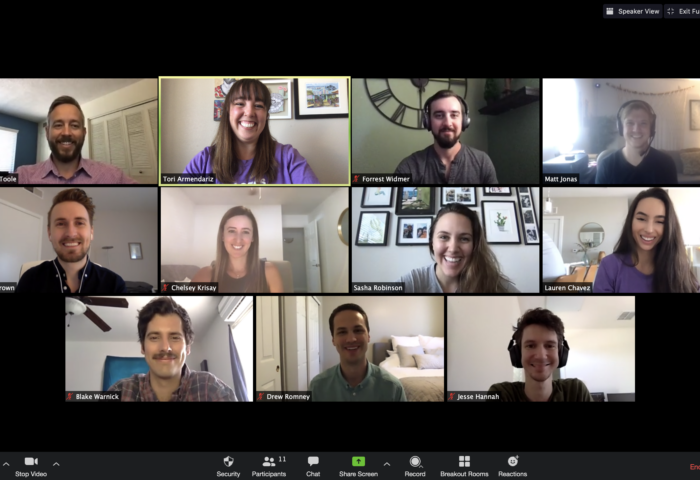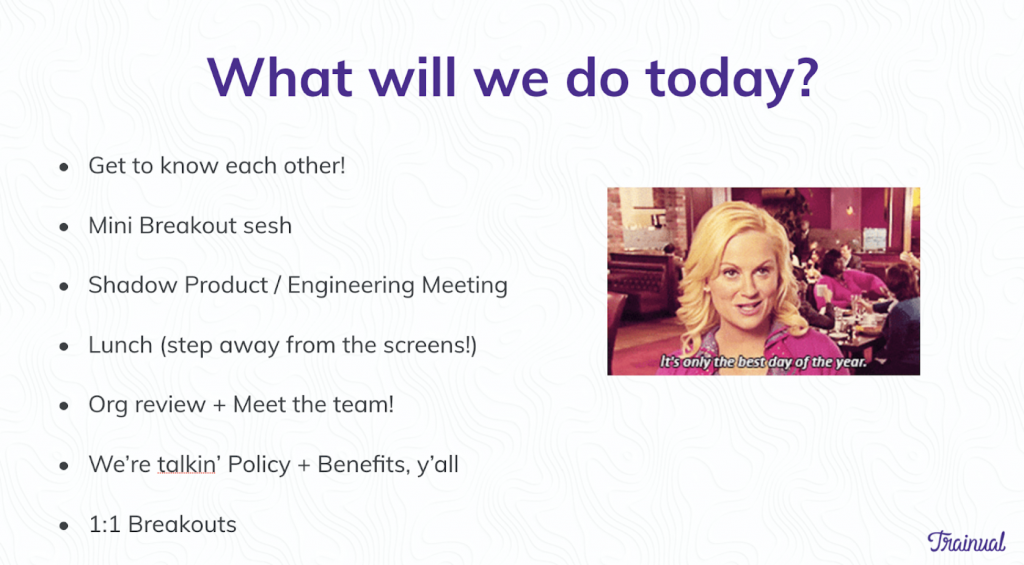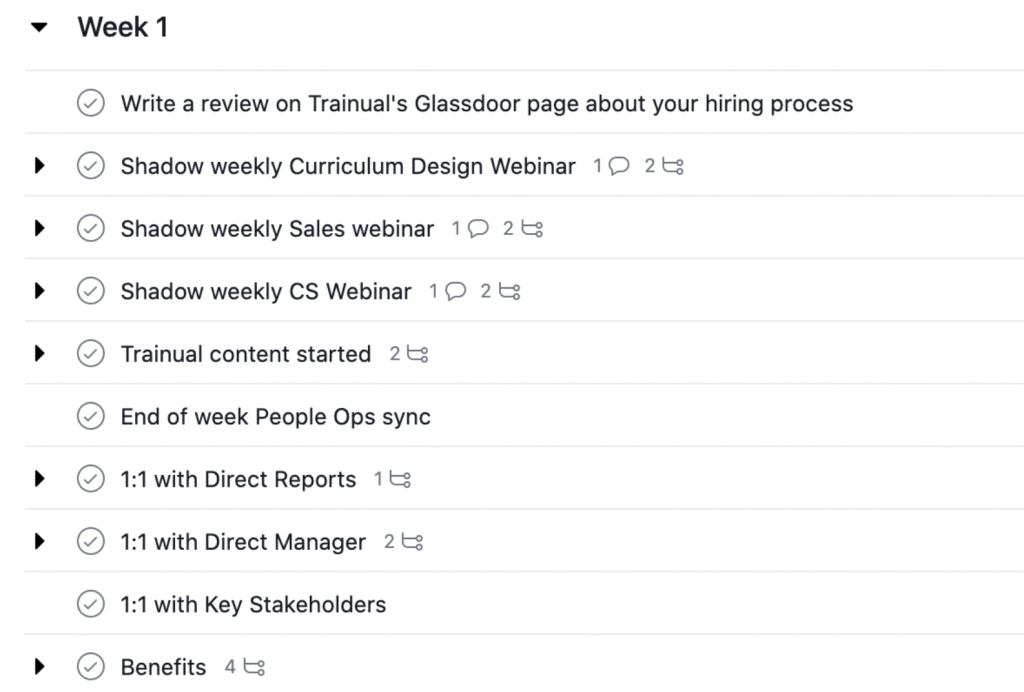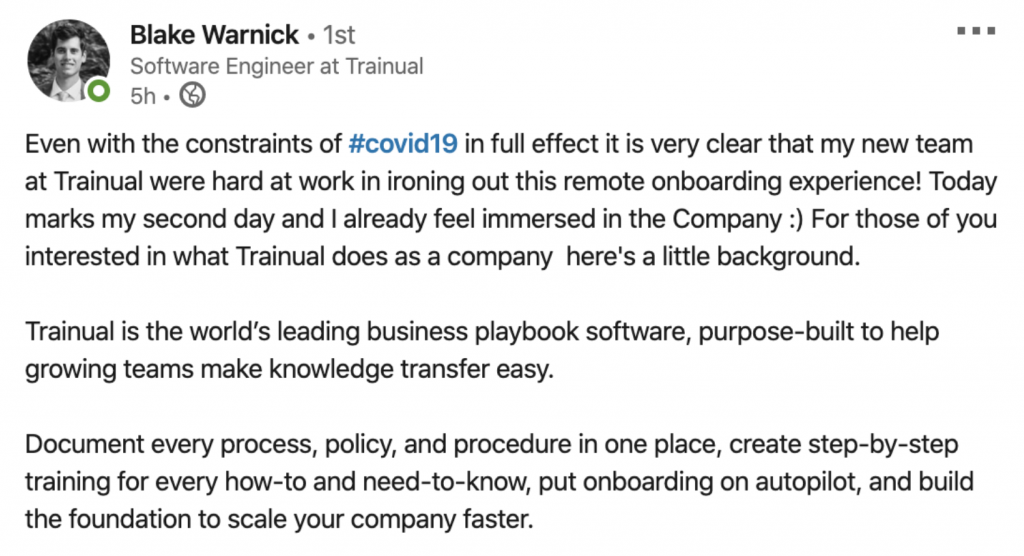
Articles
A Step-By-Step Guide To Remote Onboarding
May 5, 2020

Almost 10 weeks ago, I started as the People & Experience Coordinator at Trainual. Still a newbie myself, I now own our New Employee Onboarding (or NEO, as we call it).
And last week, I ran my first-ever onboarding experience… and it was totally remote! It was also our largest cohort EVER with 8 people starting on the same day, and skill levels ranging from early career to 20+ years of experience. My job was to plan a week that felt equally personal and authentic for each of them.
Here’s step-by-step how we made it happen flawlessly (if I say so myself):
Let’s talk about remote onboarding first
Okay, so maybe the remote onboarding experience wasn’t entirely without flaws… but it was definitely really great!
And if I’m being honest, remote onboarding is much harder than in person. Things that used to take me 15-seconds and no coordination, suddenly required a LOT more time and effort. Take introducing our new hires to the rest of the company, for example. What was a quick walk around the office is now a synchronized Zoom dance.
Lucky for me, this was not the company’s first time! A few weeks back, we hosted our first-ever remote onboarding (with Sasha, our Head of People Ops, at the wheel), and boy, did we learn a lot!
Yes, we made a bunch of mistakes (you can hear all about them here). But these mistakes gave us invaluable insights and helped make this remote onboarding experience even better!
Step 1: Process makes perfect!
The name of the remote onboarding game is organization. And the bigger the onboarding group, the more planning needs to go into making sure each employee gets what they need.
For us, this meant hyper-focusing on preparation well before Day 1! We planned a meet-and-greet first thing, followed by an overview of policies and benefits. After lunch, we reviewed the current org chart and all our plans for team growth, leaving a lot of time with their direct managers to discuss role-specifics and their 30-60-90 plans.

But with a group of 8, this got a little tricky.
We decided to host this cohort a Monday, so we could get a full week of onboarding in. But this ended up being a big, excessively stressful mistake that we will never, and I mean never, do again.
You see, a lot of our new employees had a bunch of standing Monday department meetings that their direct managers wanted them to sit in on. Don’t get us wrong, this was a great learning opportunity for them, but a little too much for a first day. (Consider this a lesson learned.)
Step 2: Situate them for success in Asana
Through a LOT of trial and error with previous cohorts, we figured out what preparations truly made a great onboarding experience. And we put those preparations as tasks in multiple templates to streamline how our People and Operations team create amazing onboarding experiences!
These templates ensure that nothing slips through the cracks. I mean, disorganization is a major buzzkill for new teammates (it can even make them reconsider their new role).
We also made a task list for each new team member to help them anticipate what their role will require. This system creates a high level of visibility, and it empowers our new people to structure their downtime when they are on their own.
In these task lists, we assign tasks for their first day, small projects for their first 2 weeks, and larger projects that will take them through their first 3 months!

Hot tips 🔥
- Write down everything that needs to be done to prepare for a new employee (or a group of them)! These include getting all their office keys ready to go, ordering all their tech, and adding them to our team page, just to give a few examples.
- Pay attention to what new employees need to do, too! Pull out your pen and paper and make a list of all of it. (If you need ideas, we’ve included a sneak peek into one of our new hire’s Week 1 task list above. ☝️)
- Turn both of those lists into a repeatable task template that can be used every time your company onboards someone new. (Be sure to include which existing team member owns each task, a priority level, and a deadline.)
Step 3: Introduce everyone informally
When we finished walking them through the org chart, we brought each department one at a time onto the Zoom to meet our new people. It was great to let everyone have some time to connect, but admittedly, it was also a disaster!
We brought each department in for exactly 5 minutes per person (so if it was a 3-person department, they got 15 minutes). We gave no guidelines for the conversation, and having that many people in one Zoom meeting made it difficult to talk!
Next time we're planning on doing it differently. Here are our ideas:
- Break it up! Introduce the new hires to your existing teams in a series of coffee meetups, spread out over their first few weeks at the company. Try to keep it to 6 or less per coffee meetup.
- For larger departments, do multiple coffee meetups. Otherwise, there are too many people to hold a comfortable conversation.
- Provide some ice breaker questions. There is nothing worse than an awkward conversation, especially with someone you are just meeting. So, better prepare the existing team members so that they can keep the conversation flowing and give a stellar first impression!
Step 4: Share what you prepared
We always put together a list of tasks in Asana, complete with due dates, for each of the new hires to complete. We also did a complete overhaul of our Trainual onboarding content to make sure we really set our new team members up for success!
I’m happy to report, these efforts went way better than our department meet-and-greet! The extra organization was incredibly helpful for both our newbies and our onboarding team. And we made sure NOTHING slipped through the cracks by clearly outlining and assigning who needed to do what.
For the new team members, there was no need to ask or guess! Having their first few weeks carefully broken down in easy-to-understand tasks empowered them to structure any downtime in the way that made the most sense to them.
Hot tips 🔥
- Create department-specific task templates. For example, our software engineers have tasks, such as reviewing our codebase, that doesn’t apply to new hires in our Marketing department. If you have a template per department, you can add those all beforehand instead of repeatedly adding them for each new hire.
- Document the process for everything they’ll be responsible for in the next 30, 60, and 90-days and share it with them on Day 1! (Remember to leave room for them to make it their own where possible.)
- Communicate the method to the madness. The process doesn’t mean anything if you haven’t clued everyone in on why you have it or what to do with it.
Step 5: Of course, lean on Trainual
Like I said before, we just finished a massive overhaul of all of our collective knowledge that we share to catch our new people up to speed faster. And the crazy thing is that it works!
Time and again, we have had feedback that people feel like they are up to speed and ready to take off the training wheels (as it were) within just 3 to 4 days of starting!

Our documentation in Trainual covers everything, ranging from company policies and benefits to in-depth breakdown of the product and company metrics.
There are also role-specific subjects that break down every process someone would need to be successful in their role. Having it all clearly documented in one searchable platform is our secret to success! (? Shh, don’t tell anyone… on second thought, please do!)
Hot tips 🔥
- Don’t overwhelm your new employees with content. Roll it out in digestible pieces. They can only process so much at once.
- Make sure the content is written by the person doing the job - then edit after if needed.
- Ask for feedback on how to make the content better, more engaging, and more helpful! Onboarding documentation can (and should) always be improved.
Step 6: Don’t forget the human element
Sure, all of the apps and softwares we use (like Asana and Trainual) enable us to provide a seamless remote experience for new employees. But if you just focus on the details and the data, you miss the human element! (Take it from us, that was one of our biggest mistakes in our first round of onboarding).
There is only one thing more important than thoroughly planning and clearly communicating those plans: creating an environment where new employees feel welcomed and included.
Even established teammates can feel lonely and disconnected (especially now that we're all remote), and that is with really great ties and relationships with their coworkers. For new employees, making those connections while remote is even harder.
Remember building strong relationships with the new teammates starts with you! Be open, be vulnerable, and make it clear that you care about them and their experience.
After I admitted to our onboarding cohort that it was my first time running an onboarding and earnestly asked for feedback, I got so much support! The whole vibe changed - it really broke down barriers.
Hot tips 🔥
- Schedule social time for each new hire to meet their team - and make sure there is a fun activity planned! At Trainual, we love hosting remote game nights with Jackbox.TV and HouseParty... just saying.
- Create a fun drip campaign for the entire first week of onboarding to re-energize your new employees each day.
- Be vulnerable with your team first! You're human, they're human. The sooner you get that out in the open, the sooner you can start building relationships.
Don't get me wrong, I definitely faced a lot of challenges throughout my first remote onboarding. But by focusing on organization and fostering genuine connections, we made a group of strangers into Trainual experts in a few short days. I already can’t wait for my next cohort (but I wouldn’t be upset if this one is in person).
Similar Blog Posts










